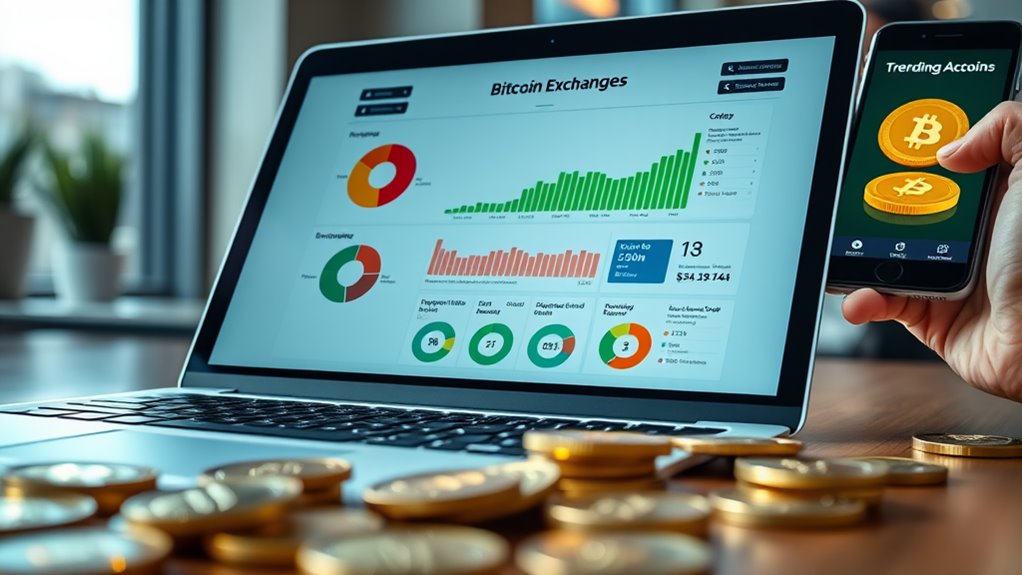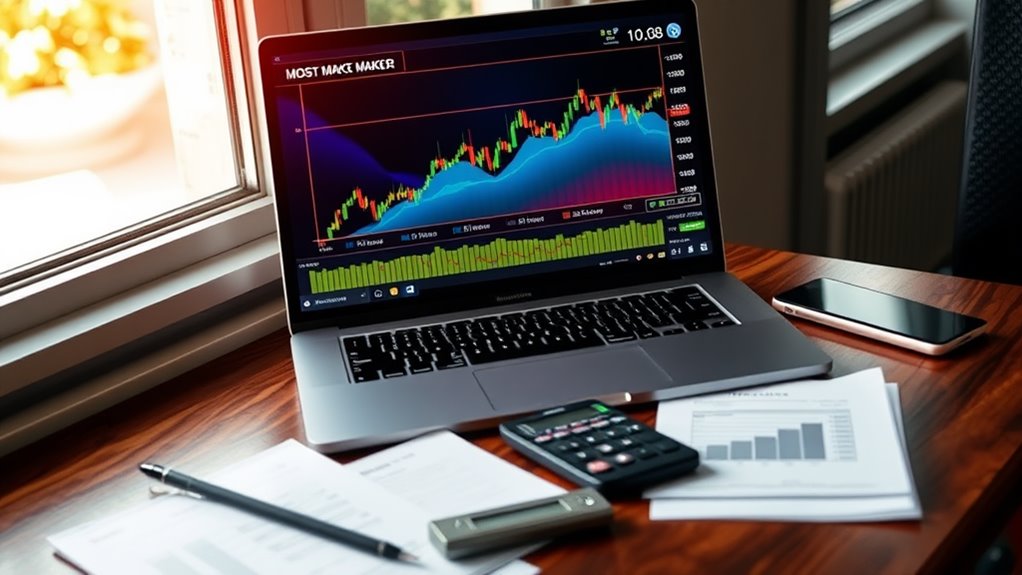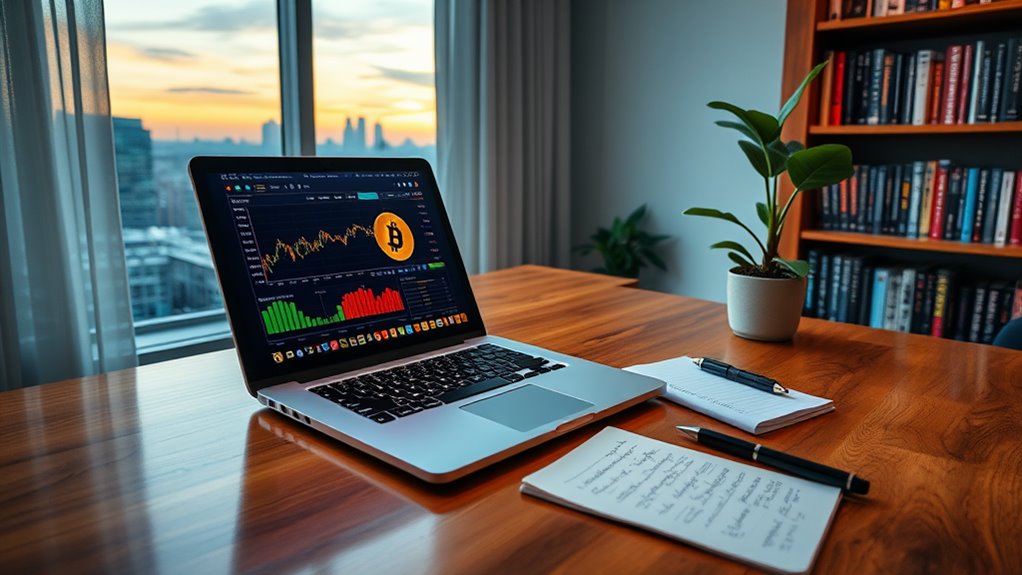
How to Choose Bitcoin Exchange for U.S. Traders
U.S. traders should choose a Bitcoin exchange by carefully reviewing several important factors. First, security features like two-factor authentication and cold storage are crucial to protect assets. Next, evaluate fee structures, noting the differences between maker and taker fees. Supported cryptocurrencies also vary, affecting trading options. User experience and regulatory compliance further influence the platform’s reliability. Additionally, customer support quality is essential for assistance. Exploring these elements will provide an all-encompassing understanding of the best exchanges available.
Table of Contents
Key Takeaways
- Assess security features like two-factor authentication, cold storage, and data encryption to protect your funds and information.
- Compare fee structures, including maker-taker fees and withdrawal costs, to understand potential trading expenses.
- Evaluate the variety of supported cryptocurrencies and staking opportunities to enhance your trading and investment options.
- Look for user-friendly interfaces and reliable customer support to ensure a smooth trading experience.
- Check regulatory compliance and licensing to ensure the exchange operates legally within U.S. jurisdiction.
Understanding Security Features of Exchanges

When evaluating a Bitcoin exchange, what security features should traders prioritize?
Security is paramount in the cryptocurrency landscape, given the prevalence of threats such as hacking and phishing. Traders should look for exchanges that implement two-factor authentication (2FA), which adds an extra layer of protection by requiring a secondary verification method.
Additionally, exchanges should utilize cold storage to keep the majority of funds offline, reducing hacking risks. Data encryption is essential for safeguarding sensitive information from unauthorized access.
Multi-signature wallets enhance security by requiring multiple approvals for transactions. Regular security audits demonstrate a commitment to identifying and addressing vulnerabilities. Furthermore, exchanges that provide essential tips to safeguard your Bitcoin from scams and hacks can further enhance a trader’s security posture.
Evaluating Fee Structures

Evaluating fee structures is a significant step for traders choosing a Bitcoin exchange, as these costs can greatly impact overall profitability. Many exchanges utilize a maker-taker model, where fees differ based on trading roles. Below is a comparison of various fee types:
| Fee Type | Description |
|---|---|
| Maker Fees | Generally lower; apply to limit orders. |
| Taker Fees | Higher fees; apply to market orders. |
| Deposit Fees | Charges for funding accounts. |
| Withdrawal Fees | Costs for withdrawing funds from the exchange. |
| Subscription Fees | Monthly fees for benefits like reduced trading costs. |
Understanding these structures helps traders calculate potential expenses accurately. It’s essential to assess both trading and ancillary fees to gauge the total cost of trading effectively. Additionally, being aware of the maker-taker model can provide insights into how different orders affect your trading costs.
Assessing Supported Cryptocurrencies

Choosing the right Bitcoin exchange involves not only understanding fee structures but also evaluating the variety of supported cryptocurrencies.
Selecting a Bitcoin exchange requires assessing both fees and the range of supported cryptocurrencies available.
The selection of available cryptocurrencies varies considerably among exchanges. For instance, Coinbase supports over 235 cryptocurrencies, while Kraken offers more than 350. In contrast, Gemini has a more limited selection, listing around 73 cryptocurrencies.
Some platforms, like Binance US and Crypto.com, cater to a broader audience by supporting numerous altcoins and DeFi tokens. However, exchanges such as bitFlyer USA and Robinhood offer fewer choices, focusing on popular coins.
Traders should consider the diversity of supported assets, including new and emerging cryptocurrencies, as this can greatly influence their trading experience and investment opportunities. Additionally, it’s important to review the top platforms to ensure you are choosing an exchange that meets your specific needs.
User Experience and Interface Design

User experience and interface design play an essential role in the effectiveness of a Bitcoin exchange platform. A well-designed interface can appreciably enhance user engagement and satisfaction.
Key aspects to reflect on include:
- Clear Navigation: Users should easily find features with organized menus.
- Intuitive Design: A user-friendly layout simplifies trading processes for beginners.
- Real-time Feedback: Immediate updates on transactions foster transparency and build trust.
- Customization Options: Allowing users to personalize their dashboards can enhance their experience.
Additionally, implementing a minimalist design, maintaining consistency, and providing accessibility features like screen reader compatibility will further improve user interaction.
Importance of Regulatory Compliance

Regulatory compliance is essential for Bitcoin exchanges operating in the U.S. as it involves licensing and registration with relevant authorities, ensuring that platforms adhere to legal standards.
Key procedures, such as Know Your Customer (KYC) protocols, are implemented to verify user identities and prevent fraudulent activities. Additionally, exchanges must stay informed about U.S. regulations and tax laws to ensure ongoing compliance and avoid legal repercussions.
Licensing and Registration
How can U.S. traders guarantee they are engaging with compliant and trustworthy Bitcoin exchanges? Understanding licensing and registration is essential for ensuring compliance with regulatory standards. Here are key points to reflect on:
- Federal Oversight: Exchanges must comply with regulations from agencies like FinCEN, which oversees money transmission.
- State-Specific Licenses: Each state has its own licensing requirements; for instance, New York mandates a license from the NYDFS.
- Compliance Complexity: Maneuvering through federal and state regulations can be challenging, necessitating robust compliance programs.
- Jurisdictional Awareness: Businesses must adhere to regulations in all areas where they operate, ensuring legal operation across multiple states.
- Additionally, understanding that states like NY, CA, TX have diverse approaches to Bitcoin regulation can help traders make informed choices when selecting exchanges.
KYC and Compliance Procedures
In the rapidly evolving landscape of cryptocurrency, KYC (Know Your Customer) and compliance procedures play an essential role in ensuring the integrity of exchanges.
These measures help prevent illicit activities such as money laundering and terrorist financing. To comply with regulations, exchanges must implement robust KYC processes that include verifying user identities through government-issued IDs and proof of address.
Continuous transaction monitoring is imperative to identify suspicious activities in real-time. Regulatory compliance enhances market trust, protects users from fraud, and facilitates institutional investment. However, exchanges face challenges, including user friction, privacy concerns, and the need for significant resources. As regulations evolve, the integration of advanced technologies like AI will likely play a key role in future compliance efforts. Additionally, understanding federal legal frameworks is crucial for exchanges to navigate the complex regulatory landscape effectively.
Exploring Additional Features

In the domain of Bitcoin exchanges, additional features can greatly enhance a trader’s experience. Staking opportunities allow users to earn passive income by holding certain cryptocurrencies, while advanced trading tools provide sophisticated options for analysis and strategy. Together, these elements contribute to a more versatile trading environment for U.S. investors. Many exchanges also offer advanced trading options that can cater to both novice and experienced traders, enhancing their overall trading capabilities.
Staking Opportunities Explained
Staking opportunities present a compelling option for U.S. traders looking to enhance their cryptocurrency investments. By locking up assets in a Proof of Stake (PoS) network, traders can earn rewards while contributing to transaction security.
Key aspects of staking include:
- Passive Income: Earning rewards without selling assets.
- Diverse Staking Types: Options include direct staking, staking pools, delegated staking, and liquid staking.
- Accessibility: Low entry thresholds allow smaller investors to participate.
- Security Enhancement: Staking strengthens blockchain networks, safeguarding investments.
However, traders should also be aware of risks, such as slashing penalties, liquidity constraints, and reliance on validators.
Understanding these elements is critical for making informed decisions in the staking landscape.
Advanced Trading Tools Overview
The domain of advanced trading tools offers significant advantages for U.S. traders seeking to enhance their cryptocurrency trading experience. Platforms such as Altrady enable trading across multiple exchanges from one interface, simplifying the process.
Automated trading bots, like those from Cryptohopper, allow users to implement customized strategies without constant monitoring. Features like Dollar Cost Averaging and Grid bots assist in risk management while maximizing potential profits.
Real-time price alerts from services like Good Crypto guarantee traders remain informed of market fluctuations. Additionally, advanced charting tools available on platforms such as Gemini ActiveTrader facilitate in-depth analysis.
Collectively, these tools empower traders to make informed decisions and improve their overall trading performance. Furthermore, utilizing essential tools for real-time analysis can significantly enhance trading strategies and outcomes.
The Role of Customer Support

Customer support plays an essential role in the overall experience of users on Bitcoin exchanges, particularly for traders in the U.S. Effective customer support can considerably enhance user satisfaction and trust.
Key aspects to take into account include:
- 24/7 Availability: Guarantees help is accessible at any time.
- Multi-Channel Support: Includes live chat, phone support, and email for thorough assistance.
- Help Center and FAQs: Provides users with quick solutions to common issues.
- User Reviews and Ratings: Offers insights into the reliability and effectiveness of the support team.
Analyzing Market Maker vs. Taker Fees

When traversing the world of Bitcoin exchanges, understanding the fee structure can greatly influence a trader’s success. Maker fees, typically lower, apply to those placing limit orders and contributing liquidity, while taker fees, generally higher, are imposed on traders executing immediate market orders. This distinction impacts trading strategies and overall costs.
| Fee Type | Typical Rate | Role |
|---|---|---|
| Maker | 0.1% to near zero | Adds liquidity, stabilizing the market |
| Taker | 0.1% to over 0.5% | Removes liquidity, executing trades instantly |
| Exchange Comparison | Varies considerably | Some exchanges offer more competitive rates |
Understanding these fee structures helps traders make informed decisions when selecting the right exchange, ultimately enhancing their trading experience.
Staying Informed About Future Amendments

Staying informed about future amendments in cryptocurrency regulations is essential for traders maneuvering this dynamic market. Understanding the evolving landscape can help traders make informed decisions.
Here are four key areas to monitor:
- Regulatory Changes: Follow updates from key agencies like the SEC and CFTC, as their actions shape the market.
- Legislative Proposals: Be aware of upcoming bills, such as the STABLE Act and GENIUS Act, which may influence stablecoin regulations.
- Judicial Rulings: Keep track of court cases, as decisions regarding classifications of cryptocurrencies can impact future regulations.
- Bipartisan Support: Recognize the importance of bipartisan efforts in passing thorough laws that affect the entire cryptocurrency landscape.
Frequently Asked Questions
How Do I Know if an Exchange Is Trustworthy?
To determine an exchange’s trustworthiness, one should evaluate its transparency, security measures, regulatory compliance, and user experience. Regular audits, clear ownership disclosure, and positive user feedback greatly contribute to establishing credibility and reliability.
Can I Trade Bitcoin on My Mobile Device?
Yes, individuals can trade Bitcoin on mobile devices using various apps that provide accessibility, real-time updates, and user-friendly interfaces. However, they should be aware of security risks and guarantee proper safety measures are in place.
What Payment Methods Are Accepted for Deposits?
Accepted payment methods for deposits typically include debit and credit cards, bank transfers, digital wallets, and cryptocurrencies. Options vary by exchange, influenced by geographic restrictions, regulatory compliance, and security considerations, ensuring user convenience and safety.
Are There Limits on How Much I Can Withdraw?
Withdrawal limits vary considerably across exchanges, often reaching up to 100 BTC daily for higher-tier users. Generally, verification status and residence influence these limits, impacting the overall trading experience and available funds.
How Long Does It Take to Process Withdrawals?
Withdrawal processing times vary, typically ranging from 30 minutes to several hours. Factors influencing this include network congestion, transaction fees, exchange processing speed, and identity verification requirements that can introduce additional delays.
Conclusion
To sum up, selecting the right bitcoin exchange involves careful consideration of multiple factors. Traders must weigh security features, fee structures, and available cryptocurrencies, all while ensuring compliance with regulations. User experience, customer support, and additional features also play critical roles. As the landscape of cryptocurrency evolves, staying informed about potential changes is essential. Ultimately, the right choice can greatly impact trading success, leaving traders to ponder the best path forward in this dynamic market.



